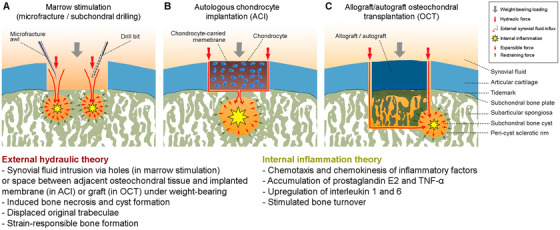FIGURE 3.

Schematic of the synergistic mechanism of external hydraulic intrusion and internal inflammatory for the subchondral bone cyst formation following articular cartilage repair procedures. The morphological change of the cyst is determined by the equilibrium status between the expansible force due to the synergistic drives and the restraining force from the peri‐cyst sclerotic rim at the cyst‐bone interface. The external hydraulic theory features an intrusion of synovial fluid into the subchondral bone through the canals generated by marrow stimulation techniques (A) or the canals that are possibly opened as a result from the surgically debrided subchondral bone plate in autologous chondrocyte implantation (B) or in a possible gap between the osteochondral unit of the graft and host in allograft/autograft transplantation (C) during the postoperative phase. The pathophysiological characteristics mainly include subchondral bone necrosis, peri‐cyst sclerotic rim formation, displaced original trabeculae and strain‐responsible formation of new bone. The internal inflammatory theory involves mechanisms such as chemotaxis and chemokinesis of inflammatory factors (e.g. PEG2, TNF‐α, IL1, and IL6) as well as bone turnover stimulated by bone necrosis
